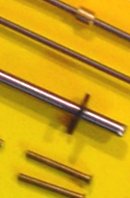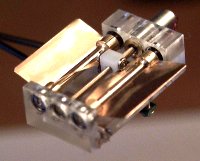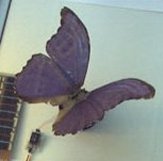Shafts and bearings
Building a small gear train with a good efficiency is not so easy.
One need adequate components and tools.We give here several hints
and DIDEL provides the components. See our price-list
if you are not coming from there.
|
 |
|
Loose gears
|
Intermediate gears may be loose on their axis. Play is 0,02mm minimum
and with POM gears, no lubrification is required. If the gear has
a 0.78 mm hole, a steel axis of 0.75-0.76mm or a rivet of 0.76 mm
in diameter is adequate. Rivets are an easy solution in many cases,
because they maintain the gear in place. The carter must be precisely
drilled (0.72 to 0.75 in soft plastic) so the rivet will fit hard,
but not too hard in its hole. It is recommended to taper the rivet
to facilitate its insertion, and avoid that the sharp rivet edge
will enlarge the hole, specially with plastics.
|
|
|
Axis with a carter
|
Axes are good and easy if the gear is maintained at both ends by
an adequate carter. The carter holes are only slightly smaller than
the axis, so the axis can be removed easily. If any play, a drop
of glue can be used to maintain the axis in place.
If the gear overhangs, one can stop the gear with a Quicklock washer
(0.8 mm axis) or, if there is no axial force, a piece of plastic
tube taken from the appropriate electric wire.
|
|
|
Elastic circle
|
|
| For axis of 1.5 mm and larger, on can use elastic circles for smooth
axis, that need a special plyer for insertion. If the axis has to
carry a wheel, a simple solution is to press-fit the wheel on the
last gear. If the wheel has been molded over a gear, the torque can
be enormous. |
|
|
|
Tight gears
|
Tight gears on a small diameter axis cannot transmit an important
torque. POM gears cannot be glued, and the pression of the gear
to the axis is low compared to metal to metal. Inceasing the difference
in diameter to increase the pression may just result in a deformation
of the gear.
For getting a better torque, one should drill a large hole in the
gear, insert a brass sleeve (bore in gear 0.02 to 0.03 mm smaller
than the brass tube), that is press-fitted through the axis (bore
in brass 0.02mm smaller).
|
|
Brass bearings
|
|
| Brass bearings are cheap and easy to implement. They
are press-fitted in the carter, with a 0.02 to 0.05 mm compression
(the bearing will not deform even with high insertion force). Their
precise inside diameter match with steel axis with a minimum play.
Watchmaker oil is recommended: the form of the bearing is designed
to keep the drop of oil in place. |
|
Ball bearings
|
Miniature ball bearings are expensive. They have to
be used when the radial effort is important. For ultra-light planes,
they have the advantage to permit a carbon rod axis. |
|
|
| You like miniature ball bearings? André
Guignard built at
the EPFL in 1998 a nice demonstrator for RMB. The butterfly wing
mechanism uses eight 3mm bearings, plus the two ones inside the 3
mm smoovy motor. If you want to see how it works, there is a beautifull
7 Meg video in MPG format. |
 |
 |
|


